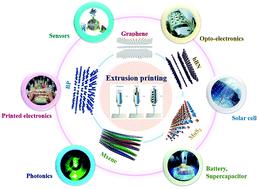Our official English website, www.x-mol.net, welcomes your
feedback! (Note: you will need to create a separate account there.)
Functional inks and extrusion-based 3D printing of 2D materials: a review of current research and applications.
Nanoscale ( IF 5.8 ) Pub Date : 2020-09-07 , DOI: 10.1039/d0nr04933f Kamrul Hassan 1 , Md Julker Nine 1 , Tran Thanh Tung 1 , Nathan Stanley 1 , Pei Lay Yap 1 , Hadi Rastin 1 , Le Yu 1 , Dusan Losic 1
Nanoscale ( IF 5.8 ) Pub Date : 2020-09-07 , DOI: 10.1039/d0nr04933f Kamrul Hassan 1 , Md Julker Nine 1 , Tran Thanh Tung 1 , Nathan Stanley 1 , Pei Lay Yap 1 , Hadi Rastin 1 , Le Yu 1 , Dusan Losic 1
Affiliation

|
Graphene and related 2D materials offer an ideal platform for next generation disruptive technologies and in particular the potential to produce printed electronic devices with low cost and high throughput. Interest in the use of 2D materials to create functional inks has exponentially increased in recent years with the development of new ink formulations linked with effective printing techniques, including screen, gravure, inkjet and extrusion-based printing towards low-cost device manufacturing. Exfoliated, solution-processed 2D materials formulated into inks permits additive patterning onto both rigid and conformable substrates for printed device design with high-speed, large-scale and cost-effective manufacturing. Each printing technique has some sort of clear advantages over others that requires characteristic ink formulations according to their individual operational principles. Among them, the extrusion-based 3D printing technique has attracted heightened interest due to its ability to create three-dimensional (3D) architectures with increased surface area facilitating the design of a new generation of 3D devices suitable for a wide variety of applications. There still remain several challenges in the development of 2D material ink technologies for extrusion printing which must be resolved prior to their translation into large-scale device production. This comprehensive review presents the current progress on ink formulations with 2D materials and their broad practical applications for printed energy storage devices and sensors. Finally, an outline of the challenges and outlook for extrusion-based 3D printing inks and their place in the future printed devices ecosystem is presented.
中文翻译:

功能性油墨和基于挤出的2D材料3D打印:当前研究和应用综述。
石墨烯和相关的2D材料为下一代颠覆性技术提供了理想的平台,尤其是潜在地以低成本和高产量生产印刷电子设备。近年来,随着2D材料与功能性印刷技术(包括丝网印刷,凹版印刷,喷墨印刷和基于挤出的印刷)相关的新型油墨配方的发展,以低成本设备制造,人们对使用2D材料创建功能性油墨的兴趣成倍增长。剥落的,经过固溶处理的2D材料可配制成墨水,从而可以在刚性和顺应性基材上进行附加图案化,以进行高速,大规模且具有成本效益的制造过程中的印刷设备设计。每种印刷技术都具有明显的优势,而其他优势则需要根据其各自的工作原理来确定油墨配方。其中,基于挤压的3D打印技术因其具有创建具有更大表面积的三维(3D)架构的能力而吸引了越来越多的关注,从而有利于设计适用于多种应用的新一代3D设备。在用于挤出印刷的2D材料油墨技术的开发中仍然存在一些挑战,必须先解决这些挑战,然后才能将其转化为大规模设备生产。这份全面的综述介绍了使用2D材料的油墨配方的最新进展及其在印刷储能设备和传感器中的广泛实际应用。最后,
更新日期:2020-10-02
中文翻译:

功能性油墨和基于挤出的2D材料3D打印:当前研究和应用综述。
石墨烯和相关的2D材料为下一代颠覆性技术提供了理想的平台,尤其是潜在地以低成本和高产量生产印刷电子设备。近年来,随着2D材料与功能性印刷技术(包括丝网印刷,凹版印刷,喷墨印刷和基于挤出的印刷)相关的新型油墨配方的发展,以低成本设备制造,人们对使用2D材料创建功能性油墨的兴趣成倍增长。剥落的,经过固溶处理的2D材料可配制成墨水,从而可以在刚性和顺应性基材上进行附加图案化,以进行高速,大规模且具有成本效益的制造过程中的印刷设备设计。每种印刷技术都具有明显的优势,而其他优势则需要根据其各自的工作原理来确定油墨配方。其中,基于挤压的3D打印技术因其具有创建具有更大表面积的三维(3D)架构的能力而吸引了越来越多的关注,从而有利于设计适用于多种应用的新一代3D设备。在用于挤出印刷的2D材料油墨技术的开发中仍然存在一些挑战,必须先解决这些挑战,然后才能将其转化为大规模设备生产。这份全面的综述介绍了使用2D材料的油墨配方的最新进展及其在印刷储能设备和传感器中的广泛实际应用。最后,









































 京公网安备 11010802027423号
京公网安备 11010802027423号